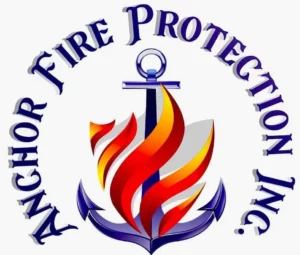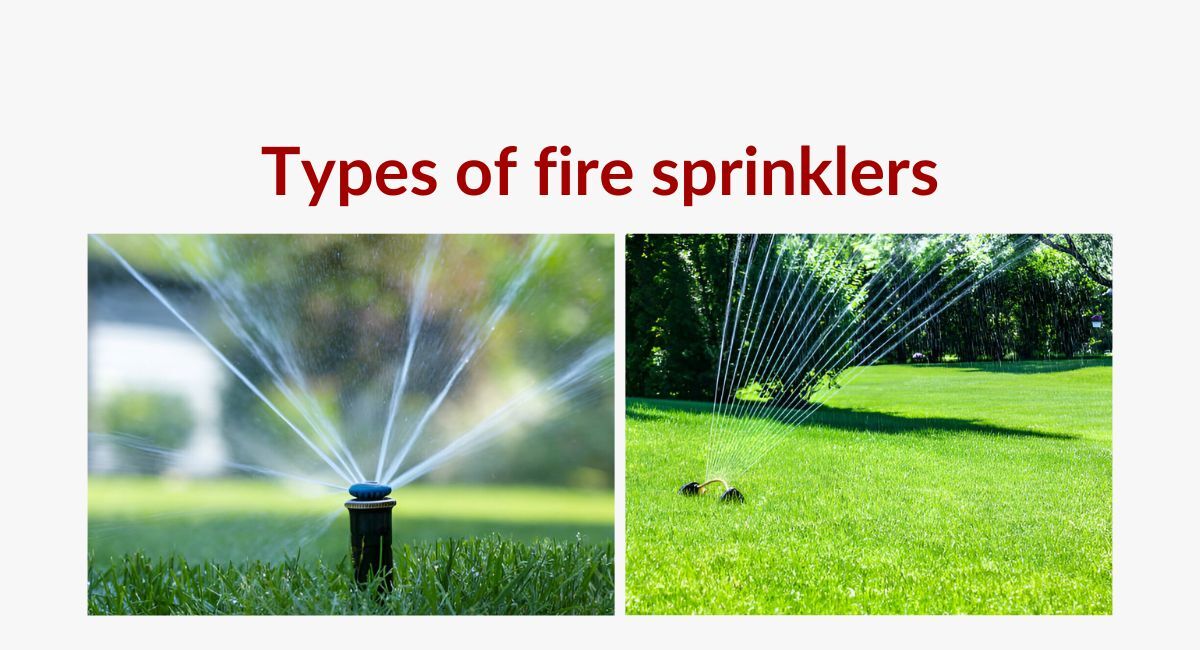What are the different types of sprinklers?
Sprinklers assist in distributing water to gardens and lawns. In contrast to a conventional garden hose, they function by using water flow and pressure to rotate internal gears and mechanisms that distribute water evenly without flooding an area in particular. Fire sprinklers are necessary for fire safety. Seeking advice from accredited experts like Anchor Fire Protection Inc. is crucial to guaranteeing that the sprinkler system you have is installed correctly and aligns with safety standards. This post discusses the various types of sprinklers that are available to assist you in selecting the best one for the particular requirements of your property.
Different Types of Sprinklers
Some sprinklers have variable settings, while others are dependent on the position of the hose nozzle. Users can carefully put one, several, or a few sprinklers in their garden, office, or yard to provide enough water.1. Fire Sprinkler Systems
A well-maintained Fire sprinkler system may reduce damage, manage smoke and flames, and give everyone time to safely escape before firefighters arrive. We will discuss four types of fire sprinkler systems based on the needs of various premises.Wet Pipe Sprinkler System
The most prevalent type of fire sprinklers in residential and commercial properties are wet pipe systems. When a fire starts, heat activates the closest sprinkler head, releasing pressurized water held in the pipes. If there is a false alert, the separate functioning of each head minimizes water damage.These systems are affordable, easy to maintain, and perfect for commercial buildings like offices and schools.Dry pipe sprinkler system
When a fire opens the valves, pressurized air or nitrogen is expelled from inside. Water then fills the pipes and spills over the fire. Dry pipe systems work well in colder climates where frozen pipes could make emergency response more difficult and costly.Pre-action sprinkler system
Pre-action systems are a kind of dry pipe system that needs to be activated twice. The pre-action valve opens to let water enter the pipes when it detects heat or smoke. At that point, each sprinkler head can turn on independently. This device is perfect for locations such as galleries, libraries, and data centers.Deluge Sprinkler System
Deluge sprinkler heads usually require an external heat or smoke sensor to activate them. When activated, water flows into the pipes and spreads to every open head, resulting in an overall flooding effect. This type of technology is frequently used in industries where volatile liquids can spread rapidly.2. Lawn Irrigation Sprinklers
A hose-end sprinkler is the kind of sprinkler that most households use. There are more types of lawn sprinkler systems and irrigation sprinkler systems available as technology advances. The most common kinds and classifications are listed here, along with some advantages and disadvantages of each.Impact sprinklers
Impact sprinklers produce a clicking sound as they rotate their arms in a circle while applying high water pressure. The powerful mist covers a wide area and resists wind effectively. Modifying the diffuser pin will change the spray force; altering the deflector shield will change the height and distance. There are 15 to 360 degrees of circular coverage possible. Adjustments can be challenging. Large lawns and locations with low-hanging trees work well with these sprinklers. If the diffuser pin is not inserted to ease the water flow, don’t use them on delicate plants or flowerbeds.Oscillating sprinklers
In North America, oscillating sprinklers are a typical feature on lawns. They provide a waterfall-like, broad, rectangular watering pattern. These sprinklers shoot thin streams of water from a long tube that has multiple nozzles on it. The water jets sweep side to side as the tube oscillates. In order to customize the width and length of the spray, choose an oscillating sprinkler with settings that are simple to operate. Larger knobs or levers and obvious indications are helpful in making changes without getting wet hands.Fixed sprinklers
These basic, reasonably priced, and user-friendly sprinklers are available in a range of sizes and styles so you may select the ideal spray pattern for your grass. A rotating selector on top allows for the selection of several spray patterns on some, while a fountain or square form is the only pattern available on some. Due to its limited reach in large yards, stationary sprinklers are best suited for smaller spaces. They function effectively even with little water pressure. Some models are capable of rapidly dispersing enormous amounts of water, but they must also consider runoff. You will need to keep an eye on the sprinkler and modify it periodically to guarantee even coverage.Rotary sprinklers
Rotary sprinklers are equipped with two or more rotating arms that spray water in a complete circular pattern. Water pressure drives the gears that rotate each arm, which has a sprinkler head at the end. Big gardens and open lawns can benefit financially from these sprinklers because of their even coverage of a large area. Shrubs and flowerbeds benefit greatly from their constant, mild spray as well. Even though rotary sprinklers usually don’t offer adjustment choices, you can alter the coverage area by modifying the spigot’s water flow.Traveling sprinklers
These are easily identified by the small tractor on wheels that travels down a pipe track. The traveling sprinkler automatically follows the hose path to avoid flooding and consistently cover vast flat surfaces. In order to avoid the sprinkler stalling and flooding specific areas of the lawn, it is best to keep an eye on it. You are going to need enough water pressure to keep it running.3. Pop-Up Sprinkler Heads
Pop-up sprinklers are designed to water your yard when activated, then withdraw to remain invisible. Underground pipes are used to link in-ground sprinkler systems to your waterline. There are three ways to know when to water: manually, with a timer, or with a smart system. As water travels through the pipes and reaches the pop-up heads, the sprinklers raise to spray water over the desired area due to water pressure.Fixed pop-up sprinklers
When water pressure builds up, fixed pop-up sprinklers emerge from underground hiding places. They work well on most lawns and offer a variety of spray patterns, like full, half, and quarter circles. Fixed sprinklers have nozzles that point continuously in the same direction and have a non-rotating spray pattern.| Advantages | Disadvantages |
| A number of options allow for complete customization of a sprinkler design. | Small, thin emitters are prone to debris buildup and hard water buildup. |
| Head replacement is simple and can be done at a reasonable cost. | Spray distance is significantly less compared with other pop-up sprinkler heads. |
Rotor pop-up sprinklers
A multiple-stream pop-up sprinkler rotates and releases thin streams of water that lower evaporation. These sprinklers, which come with spray patterns, are perfect for lawns that are uneven or sloped.| Advantages | Disadvantages |
| Streams of thin water evaporate more slowly than a fine mist. The body within is shielded from building debris. | Hard water buildup inside the head can hinder rotation and harm performance. |
Gear drive pop-up sprinklers
The gear-driven rotor pop-up sprinkler provides fine control over the spray pattern and distance since it uses a gear mechanism. The gear-driven heads distribute water evenly by operating at a constant speed. The sprinkler can shoot water farther because of the greater rotation speed that comes with more water pressure. As a result, gear-driven rotors are perfect for large, grassy lawns.| Advantages | Disadvantages |
| The coverage area, water flow, and spray arc can all be easily controlled with gear-drive rotators. | A higher minimum water pressure is required for these sprinklers to function than for other types. |
| The enclosed body is kept free of debris. | This is the most expensive type of pop-up sprinkler head. |
How can you choose the right sprinkler?
The best sprinkler for your property depends on several aspects, including wet pipe systems with permanent sprinkler heads.- Match your water pressure to your sprinkler model.
- The number and type of sprinklers needed are determined by the size and configuration of your building.
- When choosing a sprinkler system, consider severe temperatures and corrosion threats.
- In small yards, cost-effective spot or spike sprinklers with a variety of spray patterns are useful.
- Sandy soil requires sprinklers with a slower application rate, like gear-driven versions.
- Clay soil requires sprinklers with a longer throw distance to cover more ground with less water.
- Consider using drip irrigation systems to reduce waste in areas with limited water supplies.
- Use a timer attachment to automate watering, making maintenance easier.
- Adjustable spray patterns allow you to customize watering for different lawn sections.
- In areas with significant foot traffic, motion-activated sprinklers can help prevent accidental flooding.
- Cleaning sprinkler heads on a regular basis will help to prevent obstructions and keep water flowing properly.
- Look for features that conserve water, such as customizable spray patterns or several watering modes.
The Final Thought
Regardless of whether you need a half-circle or oscillating pattern, there is a sprinkler that will match your needs. In order to choose the ideal sprinkler types for your property, Anchor Fire Protection can assist you in locating local professionals. They can also help with all of your landscape needs. Get in touch with us right now for a thorough sprinkler system consultation and evaluation. We offer:- Sprinkler system design and installation
- Inspection and maintenance
- Fire safety training
FAQS
Sprinklers have four types:
1.Wet pipe sprinkler system contains water and is prepared to release it.
2. Dry pipe sprinkler system keeps water out of pipes until a fire activates the system.
3. The Pre-Action sprinkler system uses air pressure followed by water.
4. The Deluge sprinkler system releases water continuously when it is activated.
The basic sprinkler head with good coverage works best for the majority of properties. Inverted sprinkler heads spray water in a circular pattern, making them useful in confined areas or around barriers. Seek advice from a fire safety specialist when choosing a sprinkler head for specific requirements.
KEEP YOUR PROPERTY SAFE
Related posts
-
Fire Safety Tips for the Workplace
-
Fire Safety Tips for Hospitals
-
How to size fire pumps?
-
Different types of sprinklers?
-
What is fire protection system?
-
Fire Extinguisher Inspection
-
Fire Sprinkler System Components
-
What are the most common types of fire pumps?
-
How much does a fire sprinkler system cost?
-
What is active and passive fire protection?

